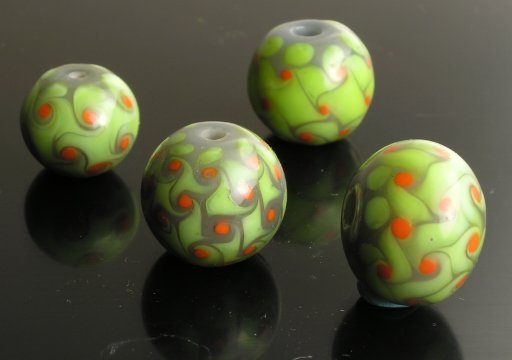If you are an animal-beadmaking lampworker, or in to those very subtle color schemes, then opaque grey is for you. I am not either of those things, so the only time I ever found it of much use was in making grey and white funeral beads for a dearly beloved. (He mostly wore those colors, so the choice worked on two levels.) Otherwise, it's sat in the bin.
So, um, getting on to close to two years now Arrow Springs sent what was for me a huge order of Bullseye (buy it now and get it at the 40# price—except the prices were so good, I ended up buying—you guessed it—40 lbs! Sigh) of which some broke. This ended up being essentially free glass, because like any sane business, UPS found it much easier simply to replace the glass, than to attempt to negotiate how much value was left in the remaining pieces. And of course they built up all sort of goodwill by letting me keep a bunch of broken pieces that I suspect the average person sells for maybe 10 cents on the dollar on ebay.
But I was stuck with the desire to tidy up all those scraps. The “prettier” colors I made into the mini-stripeys I've been featuring lately and when that palled, into more of those honking dichro focals —the next series I plan to feature, if'n I just get off my butt and finish photographing it.
In between all that, I went back to a perennial favorite, twisted
dot beads. My Lani Ching bead is made on opaque grey Bullseye glass,
and I think it might have spring green (or whatever it is BE calls
their opaque yellow-green) in it. At any rate, I concluded it might
look nice with orange dots, so after a lot, several, too many
failed color combos, I finally came up with one I liked.
I've suspected for a long time that Ms. Ching spot cases her dots with a transparent, and it's pretty obvious, comparing these beads to hers, that it's got to be (pardon the pun) the case, because I just don't see any other way to achieve that subtle color separation within the dots typical of her work.
The bead on end is what she calls the basketweave pattern, which is achieved alternating by row the rotation of twists (i.e. orange stringer). You can also, if you click on the image, see the handi-tac is peeling away from the plexi, which means the bead is canting in a gravity-defying way (not that my beads happily pose themselves on edge like that, but at least if they're not leaning 5 degrees off vertical it's a little more believable...) At least the cockeyed angle helps to disguise the slightly asymmetrical shape.
The reason the large bead in the center of the photo has such weird looking spots is that it hole-popped and though as you see I was able to otherwise save it, the evidence of its checkered past resides in a missing dot (on the backside) where it popped and the rather ucky patterning. Nevertheless, I consider it something of an achievement that I was able to rescue not only a cracked twisted dot bead (I do that rather too frequently to admit without embarressing myself) but a hole-pop.
The beautiful little bead on the left has an ugly orange splotch on the backside as well and even the seemingly perfect one in the back has a tiny bubble near the surface—so maybe I'll make some pretty jewelry out of them...
file created 06oct06
Unless otherwise noted, text, image and objects depicted therein copyright 1996--present sylvus tarn.
Sylvus Tarn